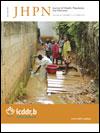Monitoring Antimicrobial Susceptibility of <i>Neisseria gonorrhoeae</i> Isolated from Bangladesh during 1997-2006: Emergence and Pattern of Drug-resistant Isolates
DOI:
https://doi.org/10.3329/jhpn.v28i5.6152Keywords:
Drug resistance, Microbial, Gonorrhoea, Neisseria gonorrhoeae, Sexually transmitted infections, Surveillance, BangladeshAbstract
Gonorrhoea is one of the most common sexually transmitted infections (STIs) in developing countries, and the emergence of resistance to antimicrobial agents in Neisseria gonorrhoeae is a major obstacle in the control of gonorrhoea. Periodical monitoring of antimicrobial susceptibility of N. gonorrhoeae is essential for the early detection of emergence of drug resistance. In total, 1,767 gonococcal strains isolated from males and females (general population and those with high-risk behaviour) from different parts of Bangladesh were studied during 1997-2006. Minimum inhibitory concentrations of penicillin, tetracycline, ciprofloxacin, ceftriaxone, spectinomycin, and azithromycin for the isolates were determined by the agar dilution method. Isolates resistant to three or more antimicrobial agents are considered multidrug-resistant. The prevalence of plasmid-mediated penicillinase-producing N. gonorrhoeae (PPNG) and plasmid-mediated tetracycline-resistant N. gonorrhoeae (TRNG) was determined. Nine percent of the isolates were resistant to ciprofloxacin in 1997 compared to 87% in 2006. Multidrug-resistant N. gonorrhoeae have emerged in 1997, and 44% of the strains (n=66) isolated during 2006 were multidrug-resistant. Forty-two percent of the isolates in 2006 were both PPNG- and TRNG-positive compared to none in 1997. The rapidly-changing pattern of gonococcal antimicrobial susceptibility warrants the need for an antimicrobial susceptibilitymonitoring programme, and periodical analysis and dissemination of susceptibility data are essential to guide clinicians and for successful STI/HIV intervention programmes.
Key words: Drug resistance, Microbial; Gonorrhoea; Neisseria gonorrhoeae; Sexually transmitted infections; Surveillance; Bangladesh
DOI: 10.3329/jhpn.v28i5.6152
J HEALTH POPUL NUTR 2010 Oct;28(5):443-449
Downloads
274
196

